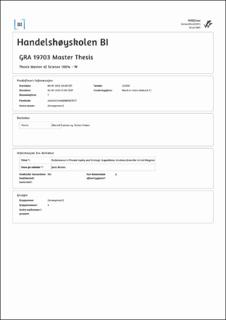| dc.description.abstract | The global M&A market has grown remarkably from 2013 to 2017, with a 45%
increase in the number of deals and a 320% growth in total value (Institute of Mergers,
Acquisitions and Alliances, 2023)[39]. The major industries involved were financials,
energy, power, consumer products, high technology, and industrials (Institute of
Mergers, Acquisitions and Alliances, 2023)[39
In 2019, M&A activities fell by 6.9% due to weak Eurozone growth and
Brexit, with PE deals forming 27.5% of the total UK acquisitions (Mergermarket,
2020). Despite the COVID pandemic and Brexit, there were no significant delays
in the UK acquisition market in 2020, although the value of acquisitions was lower
(Office for National Statistics, 2022)[53]. However, both inward and domestic M&A
values increased in 2021, peaking in March but declining again by December 2022
(Office for National Statistics, 2023)[52]. Domestic and inward acquisitions made up
about 85% of all acquisitions from 2019-2022 (Office for National Statistics, 2023)[52].
Challenging financial conditions, lower confidence, and increased volatility
impacted M&A activity, with rising costs inducing market uncertainty and a slowdown
(Bank of England, 2023)[23]. Despite this, PE funds in the UK have a record level
of ”dry powder”, i.e. unallocated capital (Zerdin, 2023; Gillen et al., 2022). The
UK market underperformed the global average in Q1 2023 due to a lower growth
forecast (Deloitte, 2023)[22]. The volume of UK mergers and acquisitions decreased
by 30%, with future trends leaning toward all-equity transactions and limiting deal
sizes (Deloitte, 2023)[22]. However, there is no scarcity of liquidity, and with ample
”dry powder,” MA market activity could increase, which bodes well for future value
creation.
This thesis advances research on the comparative performance of Private
Equity (PE) and strategically acquired targets in the United Kingdom’s M&A market.
By examining a sample of 134 PE-acquired and 283 strategically acquired targets
between 2013 and 2017 and using comprehensive data sources available from 2012
to 2021, this study offers novel insights into the performance dynamics of these
two types of acquisitions. While academic discourse has extensively explored the
strategies and performance of PE and strategic acquirers, this study differentiates
from previous literature by investigating the impact of these strategies on postacquisition
performance in terms of three distinct models. We evaluate the average
change in financial performance ratios as well as an regression of TFP and ROA. These
three models combined provide a unique approach to capturing the characteristics and performance of the two target types, pre- and post-acquisition. In addition, our
study fills a research gap by investigating post-acquisition performance specifically
within the context of private equity transactions during the COVID pandemic as well
as the period encompassing the Brexit referendum and its aftermath. This unique
focus makes our research a valuable contribution to the existing academic literature,
particularly in the contrasting of private equity and strategic transactions. | en_US |
